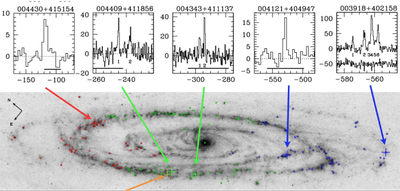Water Masers in the Andromeda Galaxy: The First Step toward Proper Motion
Investigators: Jeremy Darling (Univ Colorado-Boulder)
 We have detected and confirmed five water maser complexes in the Andromeda Galaxy (M31) using the Green Bank Telescope. These masers will provide the high brightness temperature point sources needed for proper motion studies of M31, enabling measurement of its full three-dimensional velocity vector and its geometric distance via proper rotation. The motion of M31 is the keystone of Local Group dynamics and a gateway to the dark matter profiles of galaxies in general. Our survey for water masers selected 206 luminous compact 24 micron-emitting regions in M31 and was sensitive enough to detect any maser useful for ~10 microarcsecond per year astrometry. The newly discovered masers span the isotropic luminosity range 0.3-1.9 x 10^-3 L(Sun) in single spectral components and are analogous to luminous Galactic masers. The masers are distributed around the molecular ring, including locations close to the major and minor axes, which is nearly ideal for proper motion studies. We find no correlation between 24 micron luminosity and water maser luminosity, suggesting that while water masers arise in star-forming regions, the nonlinear amplification pathways and beamed nature of the water masers means that they are not predictable based on IR luminosity alone. This suggests that there are additional bright masers to be found in M31. We predict that the geometric distance and systemic proper motion of M31 can be measured in 2-3 years with current facilities. A "moving cluster" observation of diverging masers as M31 approaches the Galaxy may be possible in the long term.
We have detected and confirmed five water maser complexes in the Andromeda Galaxy (M31) using the Green Bank Telescope. These masers will provide the high brightness temperature point sources needed for proper motion studies of M31, enabling measurement of its full three-dimensional velocity vector and its geometric distance via proper rotation. The motion of M31 is the keystone of Local Group dynamics and a gateway to the dark matter profiles of galaxies in general. Our survey for water masers selected 206 luminous compact 24 micron-emitting regions in M31 and was sensitive enough to detect any maser useful for ~10 microarcsecond per year astrometry. The newly discovered masers span the isotropic luminosity range 0.3-1.9 x 10^-3 L(Sun) in single spectral components and are analogous to luminous Galactic masers. The masers are distributed around the molecular ring, including locations close to the major and minor axes, which is nearly ideal for proper motion studies. We find no correlation between 24 micron luminosity and water maser luminosity, suggesting that while water masers arise in star-forming regions, the nonlinear amplification pathways and beamed nature of the water masers means that they are not predictable based on IR luminosity alone. This suggests that there are additional bright masers to be found in M31. We predict that the geometric distance and systemic proper motion of M31 can be measured in 2-3 years with current facilities. A "moving cluster" observation of diverging masers as M31 approaches the Galaxy may be possible in the long term.
Publication: Astrophysical Journal Letters. arXiv: 1103.4788 (6 Apr 2011)




Connect with NRAO